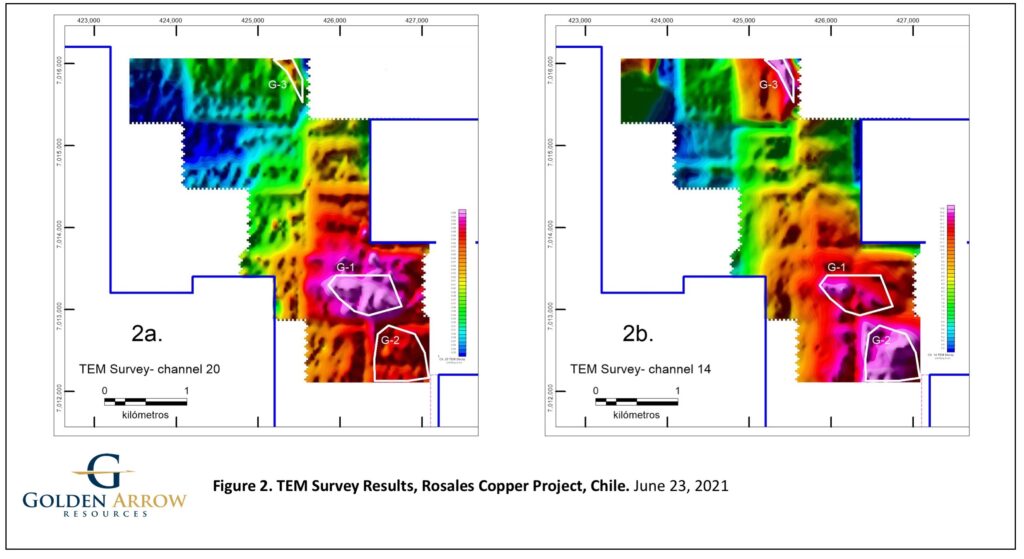
(Golden Arrow, 24.Jun.2021) — Golden Arrow Resources Corporation (TSXV: GRG) (FSE: G6A) (OTCQB: GARWF) reported that the Transient Electromagnetic (TEM) surface geophysical survey at the Rosales Copper Project has identified large, near-surface conductive anomaly targets and prompted the Company to plan its first drill campaign at the project. Furthermore, based on the results to date the Company has applied for an additional 900 hectares of concessions adjacent to the southern boundaries of the project area (See Figure 1).

“The TEM survey has performed even better than expected, and we are excited to have identified significant areas with near-surface anomalies that are prospective for sulphide copper mineralization,” stated Brian McEwen, Golden Arrow VP Exploration and Development. “Drill testing these is now our priority and we plan to start that imminently.”
The highest priority target based on size, strong conductivity and correlation with high-copper values in surface rock-chip samples is a conductive area of 850 by 500 metres that may include several conductive zones (“G1”, see Figure 2a). The shallowest part of anomaly is estimated to be at approximately 100 metres below surface with the depth extent still to be determined. A second large conductive anomaly is situated approximately 500 metres to the southeast, (“G-2” see Figure 2b) with dimensions of 600 by 400 metres, and it is open to the south. The upper reaches of this anomaly are also interpreted to be within 100 metres of surface. A third conductive target has been identified 2650 metres to the northwest of G1.

Following the TEM survey, Golden Arrow engaged Quantec to complete a 440 line-kilometre ground magnetic survey at 100-metre line separation to provide additional detailed geophysical information throughout the entire project area and to detect possible porphyry targets at depth. The new survey is underway and expected to be completed by approximately the end of June.
Compiled interpretation of both surveys will allow final targets to be refined for drill testing. A tender for reverse circulation (RC) drilling of up to 2,000 metres has been put out for bid, with a plan to commence drilling in August.
Rosales Project and Program Details
The Rosales Project currently includes 3444 hectares of 100% held mineral claims (not including 900 additional hectares under application). The project is road-accessible and is situated less than 90 kilometres from the mining centre of Copiapo, with world-class exploration and mining infrastructure readily available. The Project is situated in the Atacama Region, a prolific mining region that hosts multiple large precious and base metal mines.
The initial reconnaissance program at Rosales identified two general areas of prospective mineralization: The Margarita Mine trend (MMT), and the NW Target. The MMT is a 3.5-kilometre-long structural corridor, oriented northeast-southwest, mainly defined by felsic dykes. Chalcocite and chrysocolla were identified in outcrop in an area covering 350 by 400 metres, and samples from this area averaged 1.74% copper with a highest value of 4.37% copper hosted in andesitic volcanoclastic rocks and andesites (See News Release dated July 20, 2020 filed on SEDAR). This mineralization is coating fractures and disseminated in the matrix of the volcanoclastic host rock. There are also indications manto-type mineralization two to four metres thick in this zone.
The NW Target is located 2.7 kilometres to the northwest of the MMT. It includes outcrop with veinlets and fractures hosting quartz-chalcocite-copper oxides within an area measuring 1,500 by 400 metres. This mineralization is hosted by porphyritic andesite and dacite, which may represent a dome complex. Eight chip samples averaged 3.19% Cu and 13.9 g/t Ag with a highest value of 5.74% Cu and 37.1 g/t Ag (See News Release dated July 20, 2020 filed on SEDAR).
The goal of the geophysical program announced on April 29, 2021, was to detect and delineate prospective electromagnetic conductor responses consistent with near-surface copper stockwork mineralization, potentially related to larger copper systems at depth, and associated with surface anomalies in the MMT and NW target areas described above. Quantec Geoscience Chile Ltda. (“Quantec”) was awarded the contract for completing the survey. Golden Arrow also engaged independent geophysical consultant Miles Rideout to guide the program, provide additional interpretations of the data, and recommendations for next steps.
The survey utilized a Geonics Ltd. ‘Protem’ geophysical system operated with an in-loop profiling configuration, transmitting 25 Hz current in overlapping 800 m x 800 m transmitter loops and covering a total of 850 hectares. Three-component receiver measurements were acquired at 50 metre intervals along east-west lines spaced with 100 metre line separation.
Transient or time-domain electromagnetic profiling is one of the best proven geophysical techniques for the detection of conductive sulphide minerals. TEM was originally developed in Canada and has been credited with many mining discoveries over five decades. Unlike Induced Polarization surveys, TEM data are largely unaffected by disseminated pyrite mineralization and can detect and delineate conductive sulphide bodies within larger disseminated formations. Additionally, sulphide minerals associated with weak induced polarization response can present excellent TEM conductors as long as the sulphide grains form continuous paths of electrical conductivity. This is the reason that TEM surveys are preferentially sensitive to high-grade and massive sulphide bodies.
TEM profile data presents decay intervals from earliest interval (channel 1) to the latest interval (channel 20). Current in the TEM transmit loop induces secondary eddy current in the ground, from near surface to depths of hundreds of metres. Eddy currents attenuate fastest in areas with poor conductivity but persist for relatively long periods in good electrical conductors. The relative electrical conductivity of target features is often discriminated by which channels present strong anomalous response. Early-time gates typically show poor conductors such as clays or water-saturated sediment. Late-time gates only respond to the best-quality conductors, which often represent zones of metallic conductivity as found in many sulphide minerals. Better conductivity is usually attributable to more massive textures and greater conductor thickness. Chalcocite, bornite and chalcopyrite are copper sulphides often associated with high-conductivity TEM responses. Historic investigation in the Copiapo district has demonstrated that pyrite is rarely associated TEM anomalies, attributable to pyrite’s predominant tendency to form discontinuous grains, which do not facilitate electrical conduction.
In the MMT target two anomalous zones were detected; one with the highest conductivity and very strong responses to channel 20 (G-1 in Figure 2a). The dimensions of this target are 850 by 500 metres, though the target may comprise multiple conductive zones. Interpretation of the TEM profiles indicates the shallowest portions of this target are approximately 100 metres below surface. The depth extent of this target has not yet been determined. This conductive target is the highest priority target for drilling due to its size, excellent conductivity and correlation with high-copper values in surface rock-chip samples.
At 500 metres to the southeast, a second large conductive zone (G-2- Figure 2b) has been detected with dimensions 600 by 400 metres in channel 14 response. This zone remains open to the south, to the southern border of the project, and Golden Arrow has applied for three additional concessions of 300 hectares each to cover the extension of the anomaly in this area. This southeast target is somewhat less conductive than the central target, with the TEM response attenuating significantly beyond channel 17. This earlier response suggests more disseminated textures or different composition. Interpretation of TEM profiles indicates the upper portions of this target are less than 100 metres below surface. Due to its earlier-time anomalous response, this is the second priority area for drilling.
At the NW target a third conductive zone has been identified at the northern limit of the TEM survey coverage (G3 in Figure 2, 2650 metres NNW of G-1 in Figure 2a). A very broad early and mid-time response resolves to a narrow, highly conductive lineament in channel 20. This zone is approximately 100 metres wide, and has been delineated over 400 metres length, and it remains open to the north. Considering the setting this response is consistent with a highly conductive structure located below a relatively thin unit of conductive sediment. This is the third priority target. Geochemical sampling shows positive copper values at all three TEM targets, thus the Company considers all three to be highly prospective.
Golden Arrow’s geophysical consultant Miles Rideout stated “We chose the TEM profiling technique as an expedient method to directly detect high-quality sulphide targets. The observed TEM responses show broader conductors consistent with manto deposits and strong narrow features consistent with feeder structures. It is easy to recommend drilling based on these very positive results.”
Qualified Persons
The technical portions of this news release have been reviewed and approved by Brian McEwen, P.Geol., VP Exploration and Development to the Company and a Qualified Person as defined in National Instrument 43-101.
____________________

